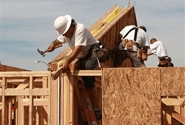Steel Markets

January Housing Permits Suggest Strong Start for 2020
Written by Sandy Williams
February 19, 2020
Housing starts slowed in January but remained at a solid pace, while building permits surged to a 13-year high.
January starts were down 3.6 percent from December to an adjusted annual rate of 1,567,000, but were 21.4 percent higher than a year ago.
Construction starts for single-family homes fell 5.9 percent compared to December. Multi-family residences of five units or more gained 3.0 percent.
“The housing recovery continues, as single-family housing starts have surpassed one million for the second consecutive month and multifamily production has been running above 500,000 for the same period,” said NAHB Chairman Dean Mon, a home builder and developer from Shrewsbury, N.J. “Meanwhile, builder confidence remains solid as demand continues to pick up.”
Construction in the Northeast was strongest, gaining 31.9 percent in January followed by a gain of 1.2 percent in the West. Winter weather stalled construction in the Midwest, falling 25.9 percent, and starts in the South were down 5.4 percent.
Permit authorizations, a predictor of future construction, were 19.2 percent higher than December and 18.9 percent above the January 2019 rate. Building permits were at a seasonally adjusted annual rate of 1,551,000. Authorizations for single-family homes grew 6.4 percent last month, while multi-unit permit authorizations increased 15.2 percent compared to December.
“While the solid pace for residential construction continues, favorable weather conditions may have accelerated production in the winter months,” said Nanayakkara-Skillington, NAHB’s Assistant Vice President of Forecasting and Analysis. “At the same time, the growth in permits is a harbinger that that market will continue to move forward in the coming months, even as builders grapple with supply-side issues like excessive regulations, labor shortages and rising material costs.”
Permit authorizations soared 34.6 percent in the Northeast, followed by gains of 8.2 percent in the Midwest, 8.0 percent in the South and 3.1 percent in the West.

Sandy Williams
Read more from Sandy WilliamsLatest in Steel Markets

Steel buyer spirits tempered by soft spot market conditions
Steel sheet buyers report feeling bogged down by the ongoing stresses of stagnant demand, news fatigue, tariff negotiations or implementation timelines, and persistent macroeconomic uncertainty.

Hot-rolled coil buyers continue seeking certainty
Steel market participants contend that buyers will remain in “wait-and-see" mode until some market stability is restored.

Latin American steel advocates warn on cheap import flood
Subsidized Chinese steel imports and cheap steel products from Association of Southeast Asian Nations (ASEAN) entering Latin American (LATAM) are threatening the region's steel market.

CRU: Steel prices fall amid global demand weakness
The forceful headwinds bearing down on steel markets across the globe have created demand challenges and sent prices southward. The US, however, challenged the global trend.

Hot-rolled price hikes garner mixed reactions from the market
Several steel market sources say they were blindsided when mills increased spot prices for hot-rolled coils this week.
